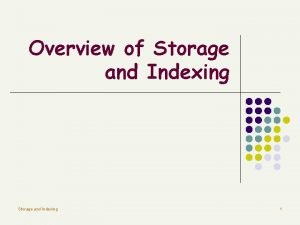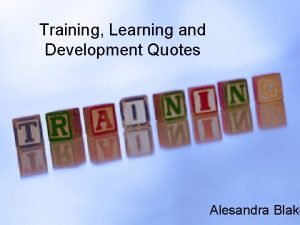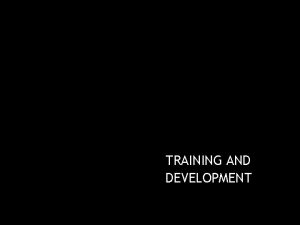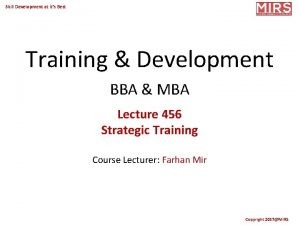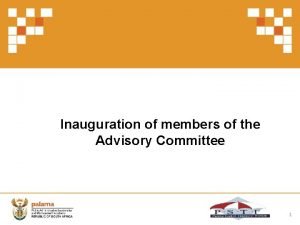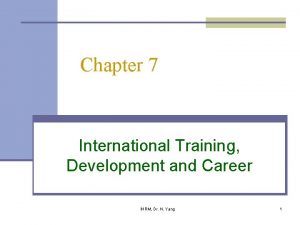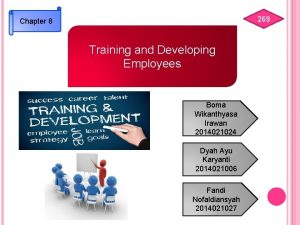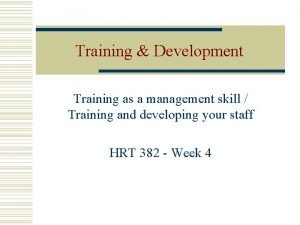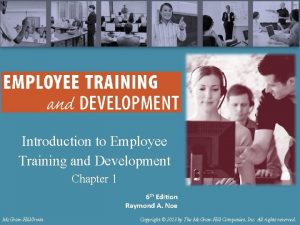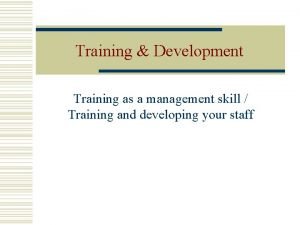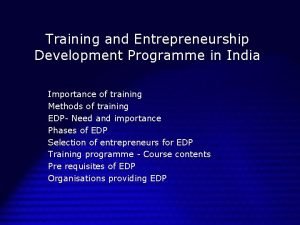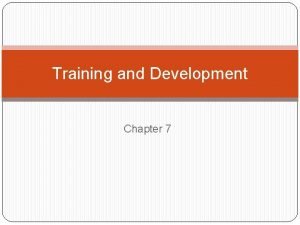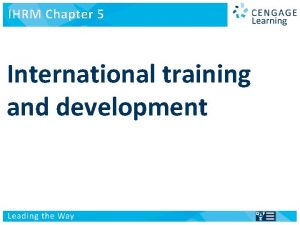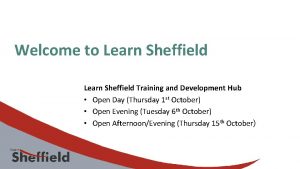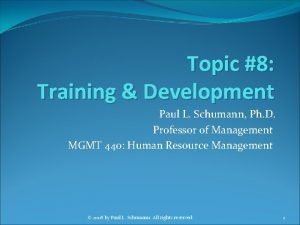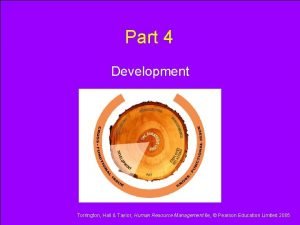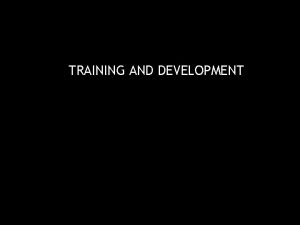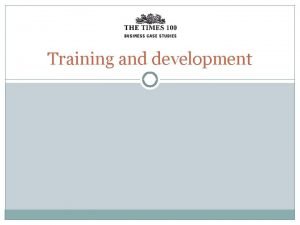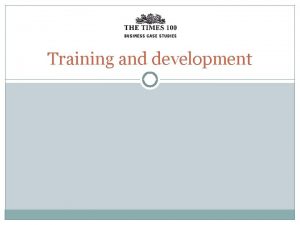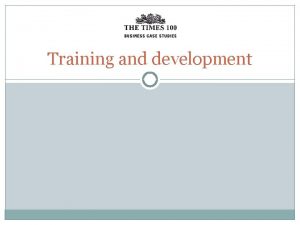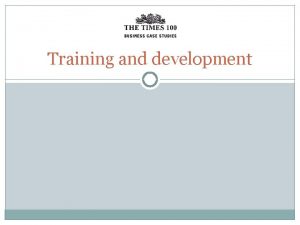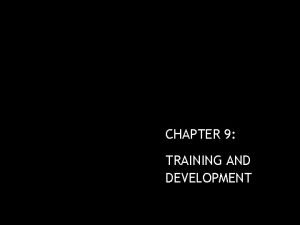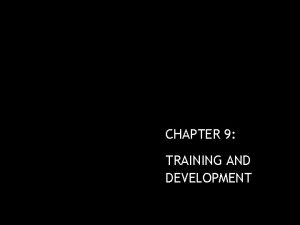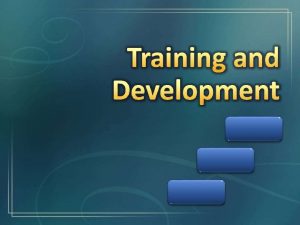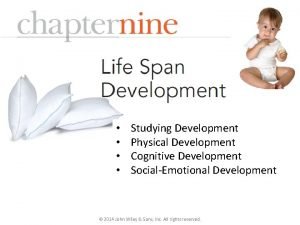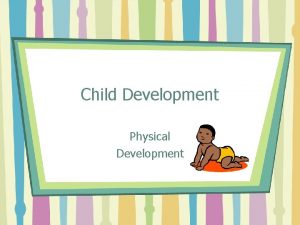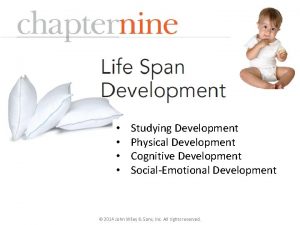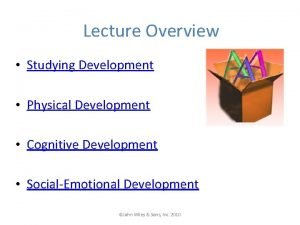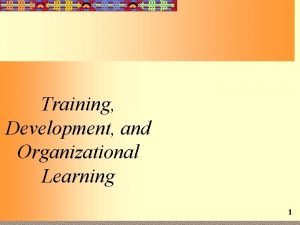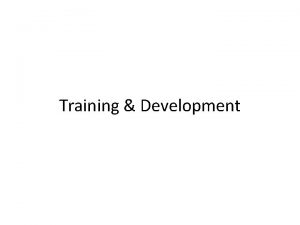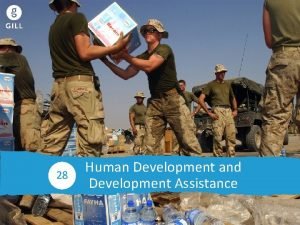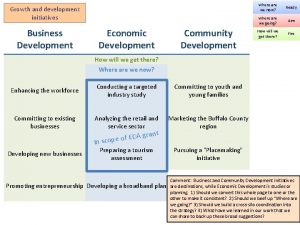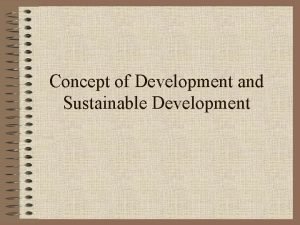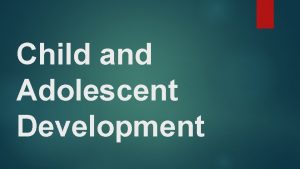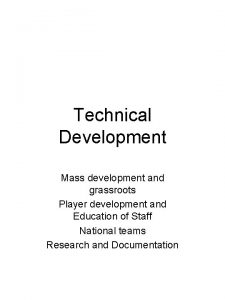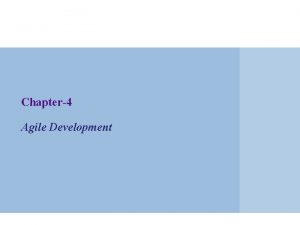Training Training and Development Overview What is training






































- Slides: 38

Training

Training and Development • Overview: • What is training? • Why training? • The basic training model Training needs evaluation Learning Training methods Training evaluation Training applications Current issues and trends • • • 2 MGMT 412 | Training Spring 2008

What is T & D? A process bringing about change in an individual’s knowledge, skills, attitude or behavior • “A process of helping individuals adjust to the corporate culture of an organization and become or remail productive as competitive, technological and organizational conditions change” (Dubois & Rothwell, 2004) • Training often implies skills needed for current job • Development often implies more general, long-range enhancement of skill set • Also, training is one of the 7 High Performance Work Practices • 3 MGMT 412 | Training Spring 2008

The Basic Training Model Training Needs Assessment Development of Criteria Instructional Objectives Selection and Design of Instructional Programs Training Outcomes Training Evaluation Training Activities 4 MGMT 412 | Training Spring 2008

Training Needs Assessment • What do we need ? • Organization analysis • Job analysis • What do we have? • Individual analysis 5 MGMT 412 | Training Spring 2008

Organization Analysis & Needs Assessment • Level of support for training and resources • Goals and strategy • Context 6 MGMT 412 | Training Spring 2008

Job Analysis & Needs Assessment • Skill analysis • What skills are needed? • How much skill must be possessed? • How can skill possession be measured? • When do skills need to be acquired? • Task analysis • Frequency and importance • Training program design Psychological fidelity 7 Skill transfer MGMT 412 | Training Spring 2008

Person Analysis • Sometimes, the training need is obvious • New employee orientation • New technology or work methods • Performance appraisal • Assessment center • Formal skill assessment 8 MGMT 412 | Training Spring 2008

What is Learning? “The process by which an activity originates or is changed through reacting to an encountered situation, provided that the characteristics of the change cannot be explained on the basis of native response tendencies, maturation or temporary states, such as fatigue” POSITIVE OR NEGATIVE 9 MGMT 412 | Training Spring 2008

Learning Issues • Learning conditions - external • Learning conditions - internal • Retention • Transfer • Types of learning 10 MGMT 412 | Training Spring 2008

Learning Conditions - External • Trainee information • Trainee knowledge or skill • Correct equipment or tools • Trainee capacity • Incentive / motivation to learn 11 MGMT 412 | Training Spring 2008

Learning Conditions - Internal • Knowledge of results • Reinforcement • Feedback • Whole vs. part learning • Massed vs. spaced practice • Overlearning 12 MGMT 412 | Training Spring 2008

Retention • Degree of original learning • Meaningfulness of learned material • Interference • Perception • Motivation 13 MGMT 412 | Training Spring 2008

Training Transfer • Similarity between training and work settings and tasks • Adequate opportunity to practice during training • Provide a variety of stimulus situations or settings during training to allow trainees to learn to generalize • Teach general principles 14 MGMT 412 | Training Spring 2008

Types of Learning • Declarative knowledge • Procedural knowledge • Cognitive strategies • Motor skills • Attitudes 15 MGMT 412 | Training Spring 2008

Training Methods - Overview • Not every organizational problem can be solved with training • Selecting a training method • Skills to be acquired • Trainee characteristics • Practical considerations • The “Hammer Theory” 16 MGMT 412 | Training Spring 2008

On-The-Job Training (1) • The most common method • What’s involved? • Watch-and-do • Special assignments or job rotation • When to use • Procedural knowledge • Skills requiring practice and feedback 17 MGMT 412 | Training Spring 2008

On-the-Job Training (2) • Advantages • Immediate transfer to work setting • Relatively inexpensive • Employee is performing productive work • Disadvantages • Not all tasks can be learned by watch-and-do • Co-worker or supervisor may not be able to train 18 MGMT 412 | Training Spring 2008

Lecture • When to use • Declarative knowledge • Large groups of people to handle • Advantages • Large number of people can be handled with a single trainer • Little need for coordination of activities • Can be adapted to video/distance learning • Disadvantages • Less likely to include two-way communication (feedback) • No opportunity for practice (procedural/cognitive knowledge) 19 MGMT 412 | Training Spring 2008

Programmed Instruction (1) • About PI and CAI • Can involve workbooks, computer programs, etc. • Now more likely to be computer-based & multi-media • Trainees move through program at own pace • Very attractive method (high-tech) 20 MGMT 412 | Training Spring 2008

Programmed Instruction (2) • Advantages • • • Can be structured to teach declarative, procedural and cognitive knowledge Opportunity for immediate feedback May be more effective than conventional classroom training Trainees can move at own pace and do not move on until previous material is learned Can be used to handle geographically dispersed or time constrained trainees Disadvantages Little human interaction • High front-end cost and time to develop • Off-the-shelf packages may not address your needs • 21 MGMT 412 | Training Spring 2008

Audiovisual • • Can be recordings, videotape / DVD, television (and incorporated into multimedia) Advantages Can show a motor skill is performed (still need practice) • Can use rewind and slow-motion • Can be used to handle geographically dispersed or time constrained trainees • Can be used to show events not easily presented in classroom (i. e. , auto accidents) • • Disadvantages Customized materials may be expensive to develop (high front-end cost) • Off-the-shelf materials may not be appropriate • One-way communication • 22 MGMT 412 | Training Spring 2008

Simulation • • Also sometimes called “vestibule training” Behaviors practiced in controlled setting Examples: flight simulator, business games, nuclear power plant procedures Advantages Trainees can practice uncommon events or emergency procedures • Can learn by error • Immediate transfer to work setting • Can be used for interpersonal and motor skill training • • Disadvantages • • Simulation equipment may be very expensive (though less expensive/hazardous than “the real thing”) The next step. . . virtual reality 23 MGMT 412 | Training Spring 2008

Role-Playing • Trainees adopt simulated roles • Advantages • Excellent method for practicing and receiving feedback on interpersonal skills • Can be used for attitude change • Depending or program, may have good transfer to work setting • Disadvantages • • 24 Time-consuming Role-playing requires skilled trainer Trainees may focus on process rather than on learning Trainees may be uncomfortable with role playing MGMT 412 | Training Spring 2008

Behavior Modification • Reinforces desired organizational behaviors • Can be used to encourage employees to apply knowledge already possessed 25 MGMT 412 | Training Spring 2008

Other Approaches to Training • Combination training • Combine classroom and OJT • Example: Apprenticeships, internships • Self-development • Common for managers, professionals • May be structured or free-form • “Embedded” training • Use of equipment and training combined • Example: Word processing “tutorials” 26 MGMT 412 | Training Spring 2008

Electronic Performance Support Systems • What is it? • • “A computer-based system that improves worker productivity by providing on-the-job access to integrated information, advice, and learning experiences" Characteristics: • • • 27 Used on the job Controlled by the worker Reduce the need for prior training: Easily updated Fast access to information Irrelevant information not included Allow for different levels of knowledge in users Allow for different learning styles Integrate information, advice, and learning experiences Artificial intelligence (eventually. . . ) MGMT 412 | Training Spring 2008

What About Multimedia? • Can be on CD, but more commonly now on company’s intranet • Involves: • • • 28 Text Video Graphics Photos Animation Sound MGMT 412 | Training Spring 2008

Training Evaluation “. . . the systematic collection of descriptive and judgmental information necessary to make effective training decisions related to the selection, adoption, value, and modification of various instructional activities” • Two questions? • • Did training work? • Why or why not? • Does it happen? • 32% to 42% of firms surveyed did not evaluate effectiveness of management training • Most evaluation focused on reaction 29 MGMT 412 | Training Spring 2008

Steps in Training Evaluation • Select the criterion (the measure or measures • • of success) Before training: pre-test After training: post-test Compare pre-test and post-test to determine if change has occurred Control group ? 30 MGMT 412 | Training Spring 2008

Levels of Training Evaluation • Reaction • Learning • Behavior • Results 31 MGMT 412 | Training Spring 2008

Training Applications • New employee orientation • Basic skills training • Management training • Training for expatriates 32 MGMT 412 | Training Spring 2008

New Employee Orientation • Why? • Socialize new employees • Results: more effective employees, reduced turnover • What should be included? • Declarative information • Parking, benefits • Basic information about organization • Organization norms and values • Training methods • Classroom • Mentoring or “buddy system” 33 MGMT 412 | Training Spring 2008

Basic Skills Training: Why? • Changes in job requirements • Interpersonal skills for service jobs • Basic literacy for all jobs • Reading/math skills for TQM environment • Changes in employees • The public schools. . . • Immigrants 34 MGMT 412 | Training Spring 2008

Management Training • Why? • Technical skills not the same as management skills • Role of manager changing • Who is trained? • Current managers • Potential managers • What does training include? • Classroom (workshops, college/university) • Role playing and simulation • Self-directed training 35 MGMT 412 | Training Spring 2008

Training for Expatriates: Why • Why? • Growing importance of international business • High rate of expatriate failures • Costs associated with expatriate failures • Does it happen? • Not with many U. S. firms • Belief that willingness = preparation • Who should be trained? • Employee • Spouse • Family members 36 MGMT 412 | Training Spring 2008

Other Current Issues and Trends • What’s actually happening ? • Multimedia training • Expensive to develop • Not the answer to everything • Distance learning • Diversity training 37 MGMT 412 | Training Spring 2008

Companies Providing Types of Training 38 MGMT 412 | Training Spring 2008
 Virusmax
Virusmax Data quality and data cleaning an overview
Data quality and data cleaning an overview Carbon family
Carbon family Chicago time
Chicago time Multicullar
Multicullar An overview of data warehousing and olap technology
An overview of data warehousing and olap technology Data quality and data cleaning an overview
Data quality and data cleaning an overview Data quality and data cleaning an overview
Data quality and data cleaning an overview Overview of storage and indexing
Overview of storage and indexing Chapter 17 overview elements and their properties
Chapter 17 overview elements and their properties Quotes on training and development
Quotes on training and development Differentiate between training and development
Differentiate between training and development Training and development metrics
Training and development metrics Fstdi
Fstdi Expatriate training in ihrm
Expatriate training in ihrm Chapter 8 training and developing employees
Chapter 8 training and developing employees Ask concept in training and development
Ask concept in training and development Introduction to employee training and development
Introduction to employee training and development Ask concept in training and development
Ask concept in training and development Edp course contents
Edp course contents Chapter 7 training and development
Chapter 7 training and development Roi pelatihan
Roi pelatihan Expatriate training in ihrm
Expatriate training in ihrm Learn sheffield
Learn sheffield Training plan for employees
Training plan for employees Conclusion for training and development ppt
Conclusion for training and development ppt Voluntarist approach to training and development
Voluntarist approach to training and development Community development background
Community development background Development that ended much development crossword
Development that ended much development crossword Pattern development is used for constructing what objects
Pattern development is used for constructing what objects Www overview
Www overview Maximo overview
Maximo overview Uml overview
Uml overview Uml
Uml Retail vertical
Retail vertical Figure 12-1 provides an overview of the lymphatic vessels
Figure 12-1 provides an overview of the lymphatic vessels Systemic veins
Systemic veins Texas public school finance overview
Texas public school finance overview Walmart inventory management systems
Walmart inventory management systems








